
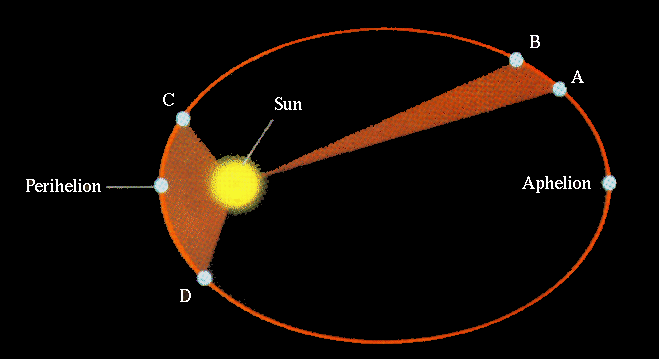
|
Binary Stars:
| Readings: Schneider & Arny: Units 56, 57 |
| (Audio Lecture) |
Planet's revolve around stars because of gravity. However, gravity is not restricted to only act between large and small bodies, stars can revolve around stars as well. In fact, 85% of the stars in the Milky Way galaxy are not single stars, like the Sun, but multiple star systems, binaries or triplets.
If two stars orbit each other at large separations, they evolve independently and are called a wide pair. If the two stars are close enough to transfer matter by tidal forces, then they are called a close or contact pair.
Binary stars obey Kepler's Laws of Planetary Motion, of which there are three.


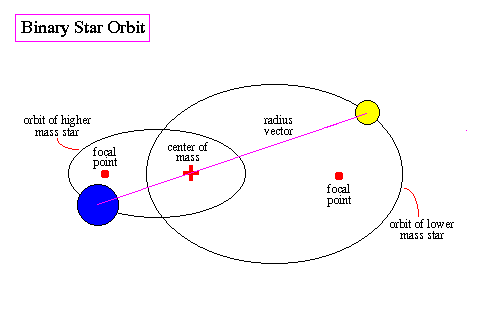
Visual Binaries:
Any two stars seen close to one another is a double star, the most famous being Mizar and Alcor in the Big Dipper. Odds are, though, that a double star is probably a foreground and background star pair that only looks near each other. With the invention of the telescope may such pairs were found. Herschel, in 1780, measured the separation and orientations of over 700 double stars and found that only about 50 pairs changed orientation over 2 decades of observation.
One such example is Sirius A and B shown below. Their motion through the sky is a complex, twisted path which takes decades to map and plot.
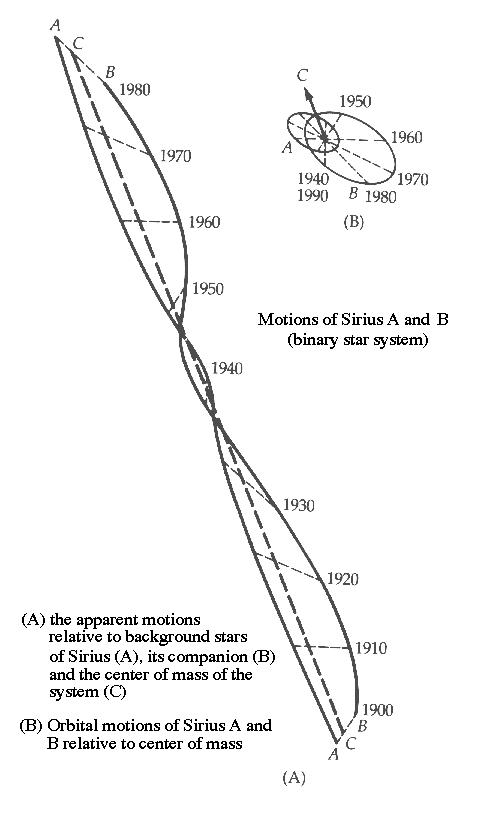
The observations made relative to center of mass of the two stars shows their respective elliptical orbits.
Eclipsing Binaries:
In the late 1600's, Italian astronomers noticed that some stars occasionally drop in their brightness up to 1/3 their peak luminosity. Later measurements showed that these declines were periodic, ranging from hours to days. It is now recognized that these brightness changes are due to the eclipsing of one star by another (as they pass in front of each other).
Eclipsing binaries are studied by monitoring their light curves (shown below), the changes in brightness with time. When the smaller, dimmer star passes in front of the brighter star, there is a deep minimum. When the dimmer star passes behind the bright star there is a second, less deep, minimum. Notice the transition zone at the start and end of each eclipse.
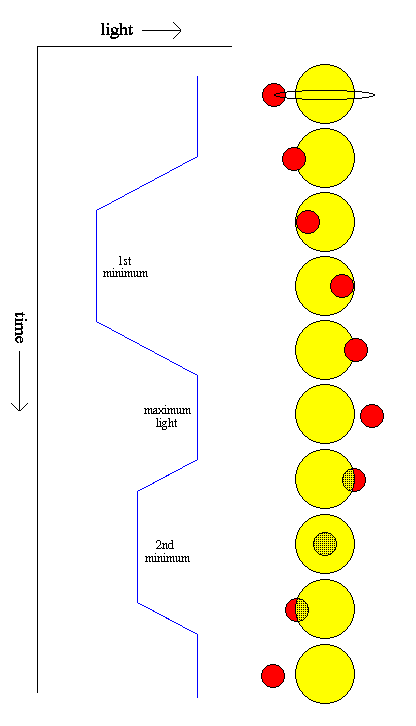
Eclipsing binaries are very rare since the orbits of the stars must be edge-on to our solar system. Notice that an eclipsing binary is the only direct method to measure the radius of a star, both the primary and the secondary from the time for the light curve to reach and rise from minimum.
Spectrum Binary:
Often a system of binary stars are too close (or too far away) to be resolved into an optical pair. However, a spectrum of such an object will display the spectral fingerprints of two different stellar types (if the stars are different in spectral type).
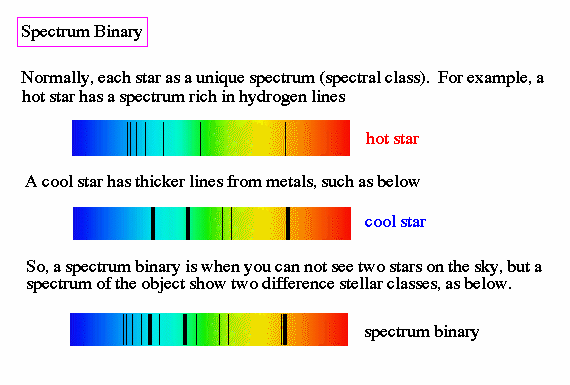
Of course, the problem with this method is that since faint, cool stars are more common than brighter stars, the odds are that the companion is too faint to be detected in a spectrum. Also, just detecting two spectrum will not determine their masses since relative velocities are needed.
Spectroscopic Binary:
Another avenue to determine the masses of stars is to measure their relative velocities via the Doppler shift of their spectral lines. This is used when the pair can not be resolved as an visual binary, but motion is seen in the spectra of one star.
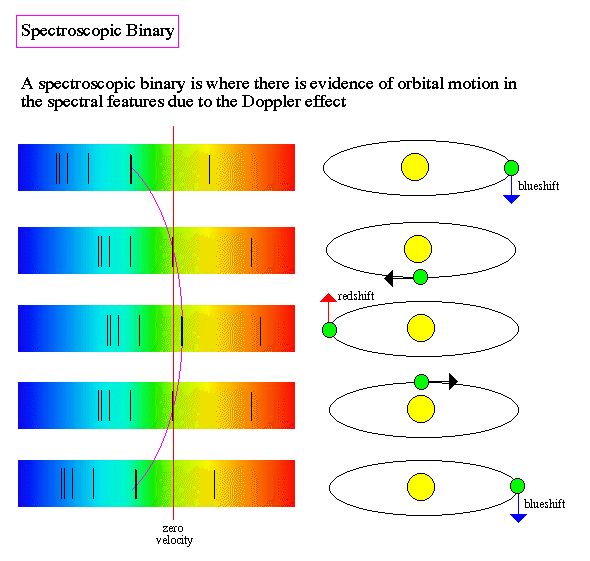
Notice that you do not need to see two spectra, only the motion of one of the stars is needed to deduce the existence of the binary system (why would one star be moving on its own?). Most binary stars are too close to separate the components, yet their existence can be deduced from Doppler shifts.
Typical velocities between binaries are 3 to 5 km/sec, so very high resolution, Coude spectra must be taken to observe this phenomenon.
Contact Binaries:
When two stars are close in separation it is possible for tidal forces to come into play. Since stars are not solid bodies, rather made of gases, then gravity can strip material and transfer it from one star to the other. Thus we say the binaries are in contact, even if their surfaces are not touching directly.
How stars exchange material is similar to the way a ball rounds over and down a hill. The ball must have enough kinetic energy to exceed the potential energy of the hill. Around two stars there are lines of equipotential. Imagine two nearby lakes. If the water rises it takes on the shape of the contours of the land, the equipotential contours. If the water level rises too high, the lakes merge.
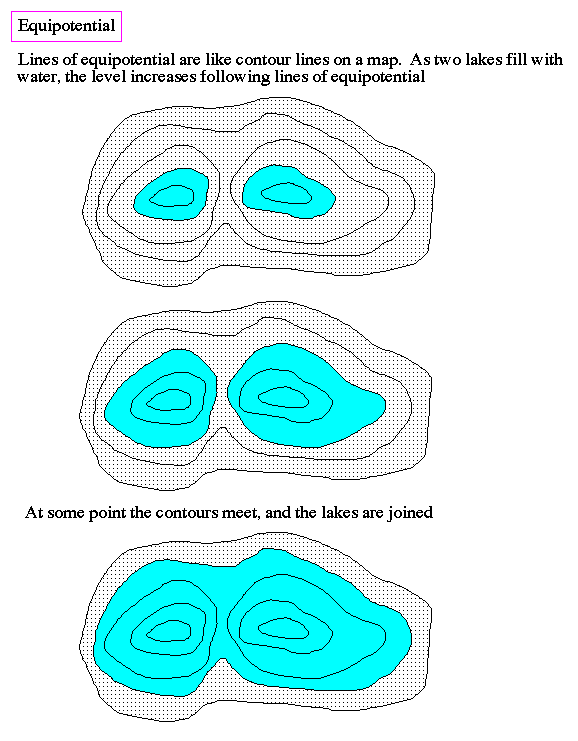
In the same way, there exist lines of equipotential around stars, where the gravitational pull from one star exceeds that of another. This line where the forces or energies balance is called the Roche lobe. When the star's radii exceed the Roche lobe, the gases are free to transfer from one star to the other. Usually in the form of a tube or stream.
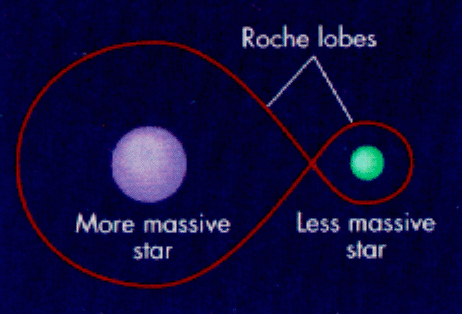
In some binary stars, such as Phi Persei, one of the binary stars evolves and expands (see stellar evolution lecture). Its surface exceeds the Roche lobe and material is streamed from one star to the other.
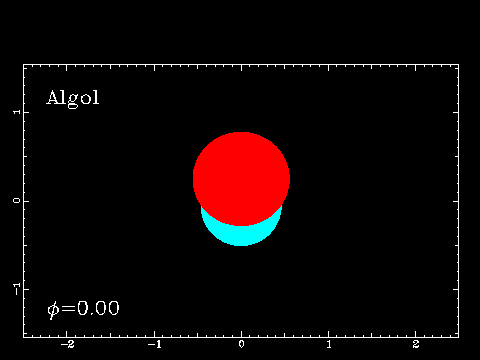
Some contact systems, such as the Algol system require sophisticated supercomputer simulations to understand the mass exchange.

|
|

|